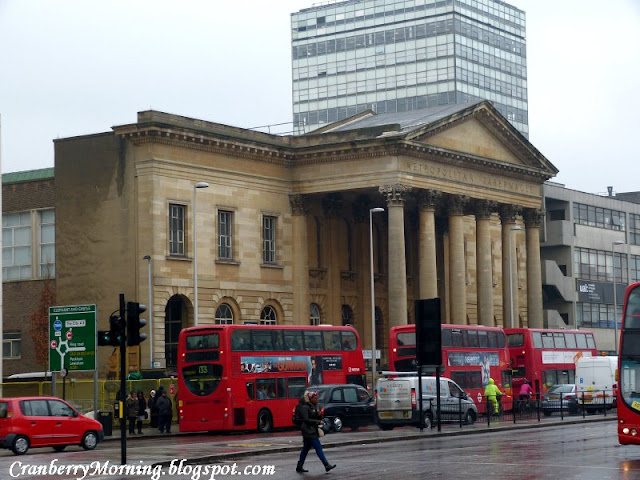There's an area of London, ESE across the river from Buckingham Palace, that's named 'Elephant and Castle.'
What does it mean??
via acorn.tv
I wondered too.
After all, most of the Tube stations have names like 'Westminster,' 'St. James's Park,' 'Notting Hill Gate,' 'Oxford Circus,' 'Bank,' etc. 'Elephant and Castle' stuck out like a sore thumb. I needed to know the origin of that unusual name.
So, I turned to the internet, because it's what we do when we have a question, isn't it!
Here are a few answers I found on Yahoo Answers...because you can't take everything you find on Wikipedia as gospel, you know. ;-)
Explanation #1:
"The name of the area derives from a pub of the same name in the area. The earliest surviving record of the pub's name is in the Court Leet Book of the Manor of Walworth. The court had met at "Elephant and Castle, Newington" on 21 March 1765. An external sign displayed in 2006 asserts that the pub was rebuilt in 1816 and 1898, although the present building, that offers budget accommodation on upper floors, appears to be of mid-20th Century construction."
Explanation #2:
"The name itself predates this account. Apocryphally, it is a corruption of the Spanish Infanta de Castile, meaning the eldest daughter of a monarch, who had supposedly landed by Royal Barge in Newington (renamed Elephant and Castle in honour of Catherine) sometime during 1501, as the betrothed to Arthur, Henry VIII's elder brother who died leaving Catherine a widow."
Catherine of Aragon
wikipedia
Explanation #3:
"Another explanation is that the land belonged to the Cutlers' Company, who had an elephant and a castle on their coat of arms. The elephant referred to the ivory used to make handles for expensive cutlery."
Explanation #4:
"The elephant and castle symbol was also used in a trade that made a far more important contribution to the London economy. It was the symbol of the Royal African Company, a group of slave-traders headed by the Stuart royal family when it retook the throne in 1660. Between the 1660s and the 1720s the company's symbol was used on British guinea coins to indicate that the source of the gold was the company's activity in Africa."
Tower of London
Explanation #5:
"The origin of the term Elephant and Castle could relate to the king's menagerie located at the Tower of London. Over the centuries various gifts were given to the monarch by visiting foreign dignitaries. Many of these gifts came with four legs and included lion, tigers, and the most regal gift of all, an elephant. It's understood that the elephant swam in the Thames and was tethered by a chain to stop it swimming away. In the mid 1800's the animals were relocated to the new London zoo at Regent's park. The only creatures at the Tower, were of course the Ravens, who, let's hope never leave if the old superstition is to be believed! The Castle?---- Well, the Tower of London itself. London's own castle."
Explanation #6: (My personal favorite)
And this one is from Michael Quinion's World Wide Words:
First, he debunks the 'infanta' idea:
"...it’s often asserted that the name is a corruption of
Infanta de Castile, usually said to be a reference to Eleanor of Castile, the wife of Edward I (in Spain and Portugal, the
infanta was the eldest daughter of the monarch without a claim to the throne). That would put
Elephant and Castle in the same class of pub name as
Goat and Compasses but, like the story of the way that name came into being, it’s almost certainly false.
"Not the least of the problems is that Eleanor of Castile wasn’t an
infanta (or at least wasn’t known as that — the term only appeared in English about 1600); the one
infanta that the British have heard about from school history lessons is Maria, a daughter of Philip III of Spain, who was once controversially engaged to Charles I. But she had no connection with Castile. The form
Infanta de Castile seems to be a conflation of vague memories of two Iberian royal women separated by 300 years."
SO.....this seems like the most likely explanation, again quoting Michael Quinion's World Wide Words:
"The
castle here is actually a howdah on the back of the elephant, in India a seat traditionally used by hunters. The public house called the
Elephant and Castle was converted about 1760 from a smithy that had had the same name and sign. This had connections with the Cutlers’ Company, a London craft guild founded in the 13th century which represented workers who made knives, scissors, surgical instruments and the like. The guild used the same emblem. The link here is the Indian elephant ivory used for knife handles, in which the Cutlers’ Company dealt.
[like explanation #3]The real story here is actually rather more interesting than the one usually told, but a lot more British people have heard of an
infanta from history lessons than know about the medieval emblem of a trade guild."
Now aren't you glad you asked!
***
***
Summer Soap Sale!
Natural, Handcrafted Vegan Soaps
...and more! Check out all my handcrafted soaps at












